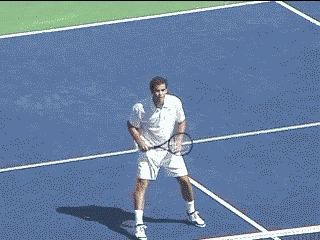| TennisOne Lessons Conquering Lob-itis Greg Moran When a high level doubles team takes the court, they do so with one thought in mind: Get to the net! These players know that the team that controls the net controls the point. In fact, tennis legend, and ten-time Grand Slam doubles champion Anne Smith, estimates that “the team that controls the net in doubles wins the point 85% of the time. So, yes the net is the place to be but for many players, venturing forward can be as frightening as a midnight stroll down a dark alley. It’s the fear of the unknown and it’s perfectly natural. As you move towards the net, you don’t know if your opponent is going to try to pass you to the left or to the right. Maybe they’ll drill the ball right at you or, God forbid, they throw up a lob. Fear of the lob is the straw that breaks many a net rushing player’s back. “Whenever I come to the net, my opponent lobs me, so I’m not coming in anymore,” is the familiar cry from recreational players. If you’re one of those players suffering from chronic lob-itis, have no fear: with a few simple steps you can learn to turn your opponent’s lob into a weapon for your team! The key to effectively handling lobs is to first recognize when they’re coming and I firmly believe this can be done 90 % of the time. When I watch recreational players move towards the net, I always look into their eyes. Sometimes I see determination. Frequently I see fear because they really don’t want to be coming to the net and are doing so only because their pro told them to. Seldom, however do I detect a look of thought or analysis. Brad Gilbert describes these players as “brain dead.” I prefer to think of them as “comatose” because that means there is hope for recovery.
I tell my players that when they take the net, their top priority is to find the answer to one question: are their opponents going to hit a lob or drive? If they get that right, I say, they can make the rest up as they go. Of course, an exaggeration but it gets them thinking. What are they going to do? Common tennis wisdom tells us to watch your opponent’s racquet to get a feel for where he/she is going to hit the shot. While this is certainly sound advice, I feel that the anticipation process can begin long before an opponent even begins racquet preparation. After you strike your shot, pay attention to how your opponents reacts. Watch their body. If they’re moving forward as they approach the ball my first instinct tells me to think drive. It takes a very skilled player to execute a lob while running forward and most players innately want to drive the ball. Moving forward encourages them to do so. Next, look at the racquet face. If it’s flat or slightly closed (strings pointing down to the court), they’ve virtually committed to the drive so you should immediately take two quick steps forward, shift slightly to the side of your ball and prepare to volley. Split step just before they make contact with the ball and then attack the volley with quick feet and a short motion.
When your approach shot has your opponent scrambling backwards or to the side, the lob alert should go off in your head. If you then notice them leaning back and their racquet face is open (strings pointing toward the sky), a lob is not far behind so position your self accordingly. I like to place myself around the service line when expecting a lob. Once the lob goes up, the first task is to determine which member of the team is going to deal with it? We’ve all the heard the old joke that asks “What is the most common word in the game of doubles?” The punch line, of course is “Yours!” There are several schools of thought on this, and I will address it in a later article, but for now, we’re going to go with the advanced approach which means that, the majority of the time: If the lob is on your side of the court it’s yours! Strong, confident players want the ball and you should develop this mentality. When that lobs goes up immediately push your left foot into the court and swing your right leg back (if you’re right-handed). Turn your shoulders and hips in the same direction and, at the same time, bring your racquet straight up past your right ear (much like when you pick up a telephone) and place it into the “backscratch” position. As your right arm moves behind your head, place your left index finger up and point at the oncoming ball. This will help you to track the ball and position yourself accordingly. If your index finger is falling in front of you, it means that the lob is short. Move in towards the net, hit a strong overhead, and end the point If you notice that your non-racquet arm is moving back over your head and you are forced to move backwards, you now have another decision to make. Blast or Bunt
Your ultimate goal with every lob is to hit the ball before it bounces. If you let the ball bounce behind you, more often than not you’ll put your team on the defensive and your opponent will move in and take control of the net and the point. As you move into position, you must make an important decision: blast or bunt. If you can get back quickly and balance yourself behind the ball, go for the blast---a strong overhead smash. If you’re struggling to hit a balanced overhead, simply turn the shot into a high volley. Take the ball out of the air and use a short motion as if you were giving your opponent a “high five.” Bunt the ball back deep, maintain control of the net and begin to anticipate the next shot. Worst case scenario
While the goal is to hit your opponent’s shot before it bounces, there will be times when a lob is just too good for you to take out of the air. In this case, run back as quickly as you can and try to get behind the ball. Don’t run directly at the ball but rather, circle around it. As you’re moving back, briefly move your eyes away from the ball and take a quick look at your opponents. If they stay in the backcourt there’s no real pressure on you. Simply lob the ball back, move into position for a baseline rally and try to get back to the net as quickly as possible. Much more likely, you’ll be faced with two players charging the net, eager to move in for the kill. Now you have to come up with something good. More often than not, this should be another lob. It amazes me how often I see players, trapped off balance six feet behind the baseline, with the ball on top of them try to rip a winning passing shot. Perhaps this is a good play if your name is Federer, Henin or your dad is Wayne Bryan but for most of us, it’s a recipe for disaster. If you can get back in time to set up behind the ball, you can consider driving a low return but, if you feel off balance in any way, throw up a lob, keep it deep and make your opponents deal with the physically demanding overhead. Remember, you always want to give your opponent the opportunity to hand you the point with an error.
Learn to Ask the Question Once you advance to the net, ask yourself that key question each time your opponents prepare to strike the ball: lob or drive? Remember, if your opponent is moving forward they’re probably going to hit a drive. If they’re backing up, look for a lob. If you’re not sure, guess lob. If you anticipate a lob, move back and you’re wrong, you’ll still get a swing at your opponent’s drive as it moves at or past you. However, if you keep charging and your opponent lobs, you’ll be stuck as the ball floats over your head. The next time you and your favorite doubles partner take the court, make a vow to control the net and remember, a lob from your opponent should not be feared. As you learn to open your mind, and read the signs, you and your partner will ultimately come to view the once dreaded lob as a point ending gift. Your comments are welcome. Let us know what you think about Greg Moran's article by emailing us here at TennisOne.
Tennis Beyond Big Shots presents a bold back-to-the-future approach. A new game that moves away from power and big shots yet is more lethal to opponents than any booming serve. Greg Moran shows players of all ages and abilities that, with simple and small changes, you can not only maximize your tennis wins and play longer, but also have much more fun doing it. Click link to purchase Greg Moran's book, Tennis Beyond Big Shots. |

